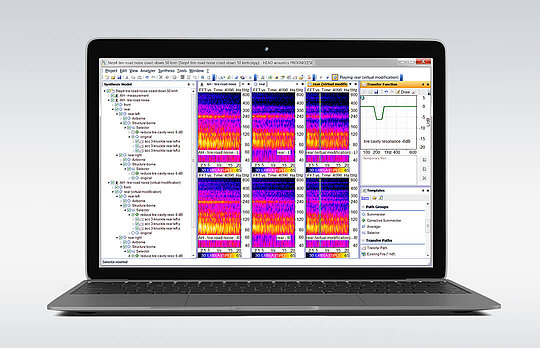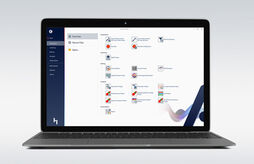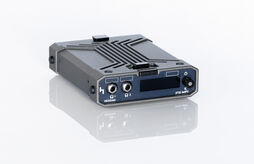PROGNO[I]SE – Software for transfer path analysis and synthesis
PROGNO[I]SE is a software program for binaural transfer path analysis and synthesis...
PROGNO[I]SE is a software program for binaural transfer path analysis and synthesis (BTPA/BTPS). With the help of transfer path analysis, the influences of individual sound paths and the general sound quality of vehicles, machinery and other products can not only be predicted by means of figures and graphics, but also be made binaurally audible.
As a powerful modeling tool, TPA offers analysis methods for characterizing individual sound paths. It is possible to create a precise model of path-related sounds and, in doing so, take advantage of numerous possibilities in terms of troubleshooting and sound design. Binaural recording and playback technology ensures the best possible realistic sound playback. Different methods are used depending on the application.
PROGNO[I]SE is a software program for binaural transfer path analysis and synthesis (BTPA/BTPS). With the help of transfer path analysis, the influences of individual sound paths and the general sound quality of vehicles, machinery and other products can not only be predicted by means...
PROGNO[I]SE is a software program for binaural transfer path analysis and synthesis (BTPA/BTPS). With the help of transfer path analysis, the influences of individual sound paths and the general sound quality of vehicles, machinery and other products can not only be predicted by means of figures and graphics, but also be made binaurally audible.
As a powerful modeling tool, TPA offers analysis methods for characterizing individual sound paths. It is possible to create a precise model of path-related sounds and, in doing so, take advantage of numerous possibilities in terms of troubleshooting and sound design. Binaural recording and playback technology ensures the best possible realistic sound playback. Different methods are used depending on the application.
Highlights
- Automatic model creation and calculation of the transfer functions for the following methods
- Structure-borne sound:
- Indirect force determination with matrix inversion (in situ or conventional)
- Blocked forces
- Effective mount transfer functions
- Airborne sound:
- Indirect determination of the volume velocity with matrix inversion
- Airborne sound sensitivity
- Structure-borne sound:
- Operational transfer path analysis (OTPA) calculates transfer functions from operational measurements without any complex additional measurements
- Easy and flexible construction of the TPA model using existing or imported transfer functions
- Trace sound phenomena back to their origins reliably: listen to and analyze individual path contributions and any desired combination (FFT vs. Time, FFT vs. RPM, FFT average, order analysis)
- Export the results for interactive playback in the PreSense NVH simulator
- Powerful signal processing
- Clear user interface, even with extensive data
- Assistance with data acquisition
Applications
-
Identification of disturbing sounds or vibrations and their relevant transfer paths.
- Root cause analysis: what is the cause of a complaint? An excessively high excitation signal, an unfavorable connection between the source and the structure or weaknesses in the transfer path?
- Gain an in-depth understanding of the system and identify requirements for subsystems
- What-if scenarios: which paths offer potential for optimization, and how much?
- Product optimization, sound design and target sound setting: virtually modify path contributions
- Combination of test and simulation: apply simulated changes derived from CAE models to measured data
- Draw conclusions early on: what does the engine of the future sound like in the vehicle? Combine test bench data from the powertrain with the TPA model of the vehicle
- Virtual prototype: integrate CAE transfer functions or source variables in the TPA model
- Preparation of data for the NVH simulator
- In the automotive industry TPA is widely used:
- Powertrain TPA
- Chassis TPA
- Auxiliary devices TPA (steering, climate control, window lifters, etc.)
- Test bench TPA: powertrain, units in the context of the vehicle
- Separation of interior sound into sound shares from to tire–road noise and wind noise
- Typical phenomena:
- Humming, ticking, knocking (IC)
- Howling (EV, HEV)
- Rattling
- The sound of a door closing
- Clunking noise
- TPA methods are also used in the following industries:
- Agricultural machinery, airplanes, helicopters, trains, etc.
- Machinery, machine tools
- Household appliances, e.g. refrigerator
Features
- Synthesis of the overall binaural or monaural sound for one or more receivers (airborne and structure-borne sound), based on transfer functions and excitation signals
- Automatic model creation and calculation of the transfer functions for the following methods
- Indirect force determination with matrix inversion (in situ or conventional)
- Blocked forces
- Effective mount transfer functions
- Indirect determination of the volume velocity with matrix inversion
- Airborne sound sensitivity
- Operational transfer path analysis (OTPA)
- Flexible model creation with existing transfer functions and source signals
- Order resynthesis, e.g. based on CAE results
- It is possible to listen to the path contributions and analyze them directly (FFT vs. Time, FFT vs. RPM, FFT average, order analysis)
- Export the results for interactive playback in the PreSense NVH simulator
- Save the time signals as HDF files
- Simple editing of the model tree
- Activation or deactivation of paths or partial models
- Any configuration and synthesis of individual paths, path groups or the sound as a whole
- Apply additional FIR or IIR filters
- Transfer function editor for manual modifications
- Contribution viewer
- Users receive step-by-step guidance through model construction
- Assistance with data acquisition: remote control of the HEAD Recorder








